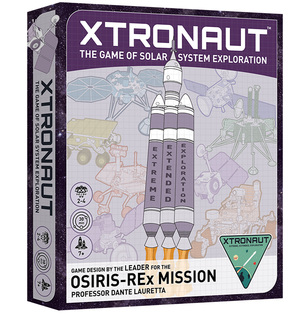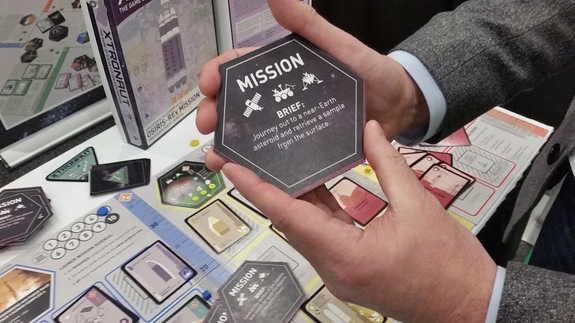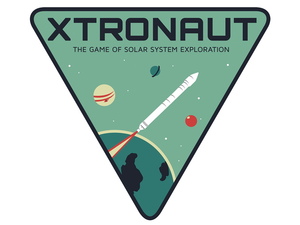
Xtronaut game creator Dante Lauretta, who also leads NASA’s OSIRIS-REx asteroid sample return mission, challenges players to fly their own space missions.
Credit: Tariq Malik/Space.com
NEW YORK — A new game, created by a NASA mission scientist, lets players take on the real-world challenges and opportunities of developing a space program: battling budget cuts, competing projects and even a government shutdown to launch research vessels into the solar system.

Designed by the leader of NASA’s upcoming OSIRIS-REx mission to an asteriod, Xtronaut lets 2-4 players build and launch space missions while racing each other and fighting real-world obstacles.
Credit: Xtronaut Enterprises
Dante Lauretta is principal investigator on the first U.S. mission to bring asteroid samples back to Earth, called OSIRIS-REx . While preparing the mission to the asteroid Bennu, which is now scheduled for launch in September, he was inspired to work on something else, too: a game where players compete to develop and execute space missions, called Xtronaut.
“What Xtronaut does is it kind of captures — for two to four players — the actual competitive nature of the spaceflight business,” Lauretta told Space.com here at Toy Fair on Monday (Feb. 15). “We had to beat out other teams in order to get our mission selected by NASA; even after that happens there’s still a lot of jockeying for resources and stuff that takes place.” [These Are the Space Missions to Watch in 2016 ]
In the game, each player is in charge of a real-world launch complex and competes to launch science missions. Each mission has certain requirements and challenges; for instance, a larger spacecraft will bring back more science data (and therefore more points for the player, who’s trying to reach 10), but it will require more power to launch and will be more challenging to build.

In the game Xtronaut, players compete to put together space missions and launch probes into the solar system.
Credit: Tariq Malik/Space.com
Players draw cards corresponding to specific real-world rockets — United Launch Alliance’s Atlas and Delta rockets, SpaceX’s Falcon and NASA’s upcoming Space Launch System — as well as other cards that can help and hinder the missions. Gravity assists can help the rockets gain extra speed, for instance. (For added realism, the Falcon 9 stage 1 rocket card is reusable and goes back into the player’s hand after launch.)
There is also a stage where players can trade components with one another, and action cards that can delay another’s mission or boost one’s own ahead in development.
“The action cards are where the real world comes into play,” Lauretta said. “There are two categories of action card: one that lets you foil your opponents like getting their mission canceled, declaring a higher national priority and stealing one of the components on their game board, subjecting them to a financial audit, making them wait out a government shutdown. And then there’s ones that can help you: a budget surplus lets you draw two, salvaging lets you go into the discard pile and pull a component out, and ‘spare parts’ lets you draw four.”
Lauretta and Xtronaut CEO and co-founder Michael Lyon brought the game to the crowdfunding website Kickstarter, where the team raised $36,873 to produce and playtest the game. From the Kickstarter campaign they also picked up two collaborators: the graphic and design team Ben Shulman and Ian Zang. Shulman designed the blueprint-like design of the game, and Zang helped refine the gameplay — like adding the trading segment, and making the actions less adversarial.
“A lot of the action cards had what’s called a ‘take that’ aspect,” Zang told Space.com. “Dante is a rocket scientist, and he based a lot of the action cards around his real experiences in industry.” But to make the game work more interactively, he encouraged paring down the game and adding moments that were more interactive, where players traded components or chose what to do with their cards.

Xtronaut’s “mssion patch.”
Credit: Xtronaut Enterprises
The game is available to order online , although the team is still looking for a larger-scale distributor. They have developed an accompanying workbook that uses the game to teach children about space missions, which is already in use at some Boys’ and Girls’ Clubs. But for the young or old, Lauretta says the game is set to entertain as well as educate.
The most common positive feedback he hears is about “the reality of it: real rockets, real performance, real missions, real math,” he said. “There’s no good and bad, it’s all about exploring. [The goal is] to have something that has the science and the rockets and the education — and people, I hope, will want to play it just because it’s a really fun game to sit down and spend the evening playing.”
Email Sarah Lewin at slewin@space.com or follow her @SarahExplains . Follow us @Spacedotcom , Facebook and Google+ . Original article on Space.com .

Comments are closed.